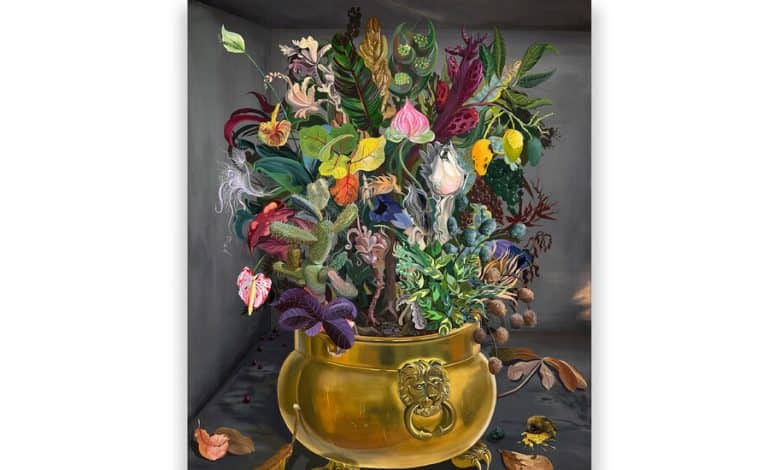Is There Something Radical About Painting Flowers?

IN EARLY 2021, Jordan Casteel, the painter known for her tender, exquisitely detailed oil portraits of Black men and other people of color in and around her Harlem community, made two unexpected moves. First, she relocated from New York City to a rural part of the Catskills, a far less populous place where she barely knew anyone. The second move, this one artistic but no less momentous, was that Casteel, 35, began painting pictures of flowers.
The first floral painting she made after arriving upstate was born of a moment of disorientation: Casteel was trying to determine how her practice would work, “being so far from people, and so far from a familiar landscape,” she says. While mulling over this predicament, she was spending hours tending her garden, a pastime that felt as generative to her as her art. At one point, she says, her husband, the photographer David Schulze, asked, “Why don’t you make a painting of the garden?” She resisted: “Nope. Couldn’t do that. Nobody cares about my garden.” But in the end, she painted “Nasturtium” (2021), a stylized rendering of the plant climbing up a wire fence, done in the incandescent, unorthodox colors (here, an almost neon violet and shades of garden greens) that Casteel often employs for human figures.
The following year, with “In Bloom” at Casey Kaplan gallery in New York, Casteel unveiled more florals and plants. There was the show’s titular painting, a wild, verdant evocation of her capacious backyard that, with its characteristic blend of her loose and tight brushstrokes, was as precisely and lovingly evoked as the people in her Alice Neel-esque portraits; and “Daffodil” (2022), pale flowers set in a candy apple red vase on a dark wooden table, done in the cinematic, blue-tinged hues of prestige television (the palette she often uses for the skin of her Black male subjects); and “Field Balm” (2022), a small painting of bare ankles emerging from a pair of celery green Crocs (on which a “Black Lives Matter” pin has been appended) standing on mulchy ground. They’re the artist’s feet as self-portrait, and a wink, perhaps, to the fact that she’s planted herself firmly in this new botanical subject matter. As it turned out, a lot of people, viewers and collectors and critics, did care about her garden.
A few months before the show opened, Casteel appeared in an Interview magazine conversation with EJ Hill, the 38-year-old Los Angeles-based artist whose intensely physical, durational performances explore the racial and gendered ideas viewers hold about the human body. Like Casteel, Hill is known for making identity-focused art — whereas Casteel paints her community, Hill explores his personal experience of being Black and queer — but has recently been creating floral paintings. His first, “Joy Studies,” a collection of small, whimsical works made in acrylic and crayon on wood, were on view (alongside a flamingo pink roller coaster that he designed for museumgoers to ride) in “Brake Run Helix,” his show that ran through last month at Mass MoCA. Hovering between realism and abstraction, these pieces, with their pink roses, puffy clouds and old-school amusement park rides drawn in rough, crosshatched lines, telegraph an almost childlike delight. Hill’s next group of flower paintings — soft, sprightly renderings made during the height of the pandemic and shown at Oxy Arts in Los Angeles in 2022 — portray roses, daisies and daffodils in saturated pastel hues, their simple floral motifs an apparent nod to Henri Matisse, who, in his 1947 book, “Jazz,” writes, “There are always flowers for those who want to see them.”
